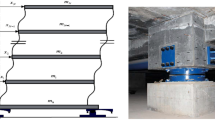Abstract
As a typical base isolation device, the friction pendulum bearing (FPB) was applied to the lattice grid structures in this paper. The isolation mechanism of FPBs was analyzed from two aspects of force and energy consumption, while the static and dynamic mechanical properties of lattice grid structures with FPBs were numerically investigated using two models of regular and oblique quadrangular pyramid framed structures. The physical models of FPBs with fictional coefficient of 0.1 and a curvature radius of 1.0 m was established and applied to the lattice grid structures. Moreover, the mechanical properties of these structures with FPBs ware studied. Numerical results indicate that the seismic response of structures is remarkably weakened by using FPBs, which means FPBs can be used to effectively control structural vibration.
Similar content being viewed by others
References
DesRoches, R. (2000). “Shape memory alloy-based response modification of simply supported bridge.” Advances in Structural Dynamics, 1, pp. 267–274.
Dunn, H. J. (1992). “Experimental results of active control on a large structure to suppress vibration. Journal of Guidance, Control, and Dynamic, 15(6), pp. 1334–1341.
EPS (2014). “Technical characteristics of friction pendulum bearings. Earthquake Protection Systems, available in: <http://www.earthquakeprotection.com/TechnicalCharacteristicsofFPBearngs.pdf>>, retrieved December 2, 2014.
Eröz, M. and DesRoches, R. (2008). “Bridge seismic response as a function of the Friction Pendulum System (FPS) modeling assumptions.” Earthquake Engineering Structures, 30, pp. 3204–3212.
Gao, W., Chen, J. J., Ma, H. B., and Ma, X. S. (2003). “Optimal placement of active bars in active vibration control for piezoelectric intelligent truss structures with random parameters.” Computers and Structures, 81, pp. 53–60.
Gaul, L., Albrecht, H., and Wirnitzer, J. (2002). “Semi-active damping of large space truss structures using friction joints.” Smart Structures, Devices, and Systems, 4935, pp. 232–241.
GB 50011 (2010). Code for seismic design of buildings. China Architecture & Building Press, Beijing (in Chinese).
Guo, Y. Q. and Chen, W. Q. (2007). “Dynamic analysis of space structures with multiple tuned mass dampers.” Engineering Structures, 29, pp. 3390–3403.
Kim, Y. C., Xue, S. D., Zhuang, P., Zhao, W., and Li, C. H. (2010). “Seismic isolation analysis of FPS bearings in spatial lattice shell structures.” Earthquake Engineering and Engineering Vibration, 9(1), pp. 93–102.
Kong, D. W., Sui, M. H., Zhi, X. D., and Fan, F. (2012). “Seismic response analysis of single layer lattice shell with FPS.” China Civil Engineering Journal. 45(S1), pp. 158–162 (in Chinese).
Lai, M. L., Change, K. C., Soong, T. T., Hao, D. S., and Yeh, Y. C. (1995). “Full-scale viscoelastically damped steel frame.” Journal of Structural Engineering, 121(10), pp. 1443–1447.
Lin, J. H., Zhang, W. S., and Sun, D. K. (1999). “Precise and efficient computation of complex structures with TMD devices.” Journal of Sound and Vibration, 223(5), pp. 693–701.
Mokha, A, Constantinou, M. C., Reinborn, M. A., and Zayas, V. A. (1991). “Experimental study of frictionpendulum isolator system.” Journal of Structural Engineering. 117(4), pp. 1201–1217.
Onoda, J., Oh, H. U., and Minesugi, K. (1997). “Semi-active vibration suppression of truss structures by electrorheological fluid.” Acta Astronautica, 40(11), pp. 771–779.
Oh, H. U. and Onoda, J. (2002). “An experimental study of a semiactive magneto-rheological fluid variable damper for vibration suppression of truss structures.” Smart Structures and Materials, 11, pp. 156–162.
Park, Y. M. and Kim, K. J. (2011). “Semi-active vibration control of space truss structures by friction damper for maximization of modal damping ratio.” Journal of Sound and Vibration, 332, pp. 4817–4828.
Schotze, R. and Goetting, H. C. (1996). “Adaptive lightweight CFRP strut for active vibration damping in truss structures.” Journal of Intelligent Material Systems and Structures. 7, pp. 433–440.
Tsai, C. S. (1997). “Finite element formulations for friction pendulum seismic isolation bearings.” International Journal for Numerical Methods in Engineering, 40, pp. 29–49.
Tsai, C. S., Chiang, T. C., Cheng, C. K., Cheng, W. S., and Chang, C. W. (2002). “An improved FPS isolator for seismic mitigation on steel structures.” Proc. 2002 ASME Pressure Vessels and Piping Conference, Seismic Engineering, Lu SC (ed.),Vancouver, Canada, 445-2, pp. 237–244.
Wang, Y. P., Chung, L. L., and Liao, W. H. (1998). “Seismic response analysis of bridges isolated with friction pendulum bearings.” Earthquake Engineering and Structural Dynamics, 27, pp. 1069–1093.
Yamada, M. (1995). “Vibration control of large space structure using TMD system.” Proc. 15th Asian-Pacific Conference on Structural Engineering and Construction, Cold Coast, Queensland, Australia, pp. 23–30.
Yang, J. S., Xiong, J., Ma, L., Wang, B., Zhang, G. Q., and Wu, L. Z. (2013). “Vibration and damping characteristics of hybrid carbon ber composite pyramidal truss sandwich panels with viscoelastic layers.” Composite Structures, 106, pp. 570–580.
Yan, Y. J. and Yam, L. H. (2002). “Optimal design of number and locations of actuators in active vibration control of a space truss.” Smart Structures and Materials, 11, pp. 496–503.
Zayas, V., Low, S., and Mahin, S. (1987). The FPS earthquake resisting system. Technical Report UCB/EERC-87/01, University of California at Berkeley.
Author information
Authors and Affiliations
Corresponding author
Additional information
Discussion open until May 1, 2015. This manuscript for this paper was submitted for review and possible publication on March 4, 2014; approved on December 1, 2014.
Rights and permissions
About this article
Cite this article
Fan, F., Kong, D., Sun, M. et al. Anti-seismic effect of lattice grid structure with friction pendulum bearings under the earthquake impact of various dimensions. Int J Steel Struct 14, 777–784 (2014). https://doi.org/10.1007/s13296-014-1209-8
Published:
Issue Date:
DOI: https://doi.org/10.1007/s13296-014-1209-8




